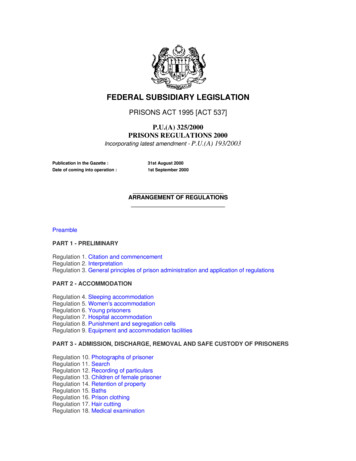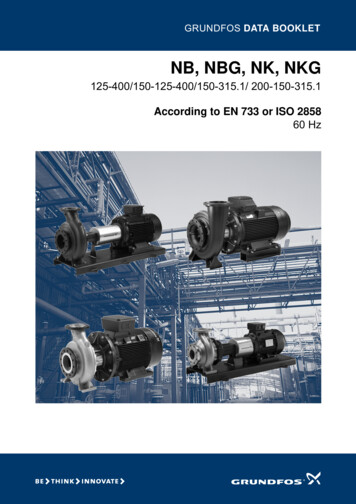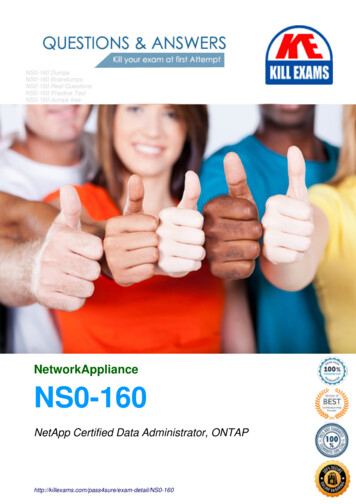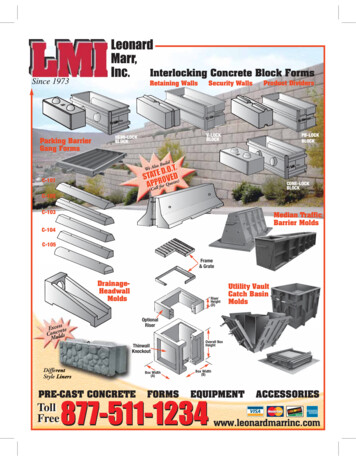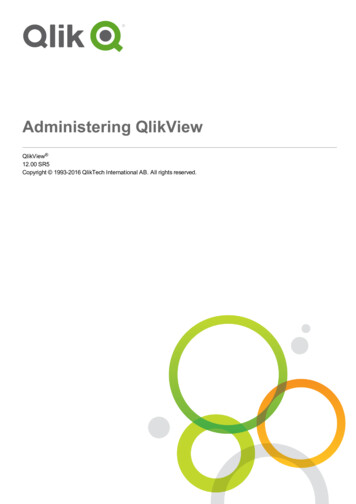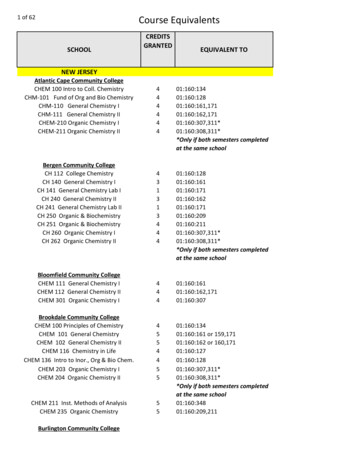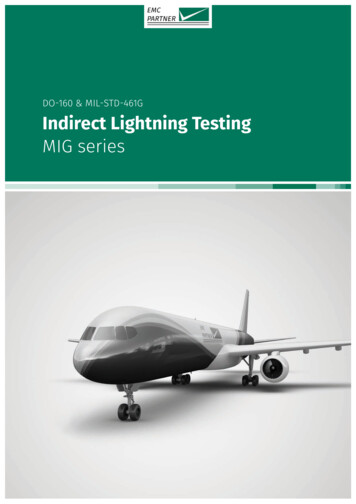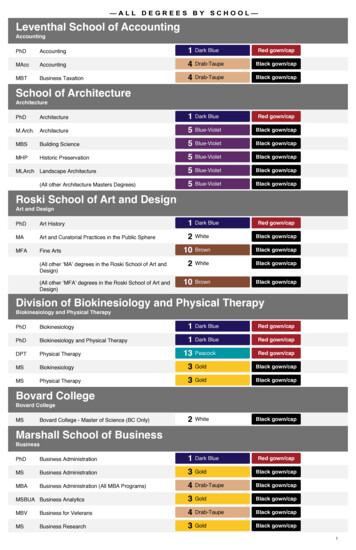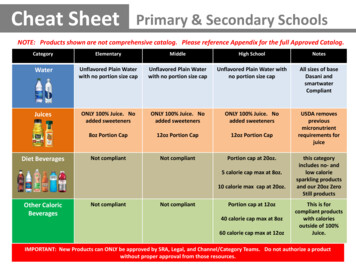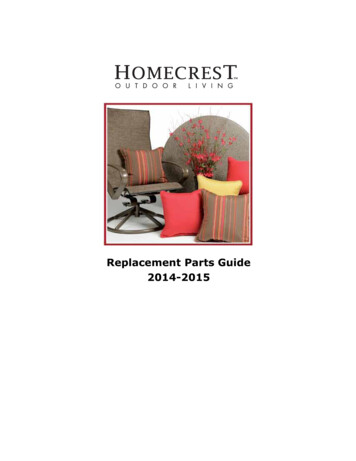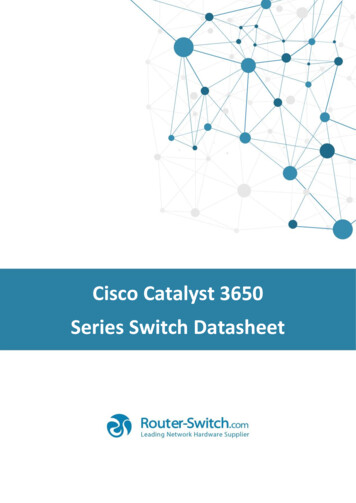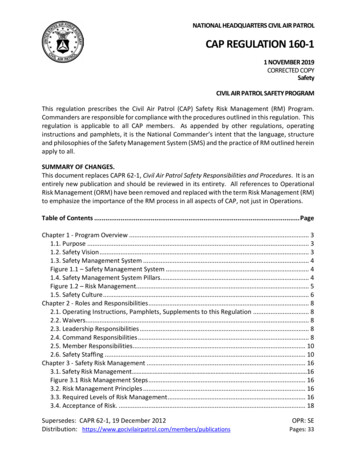
Transcription
NATIONAL HEADQUARTERS CIVIL AIR PATROLCAP REGULATION 160-11 NOVEMBER 2019CORRECTED COPYSafetyCIVIL AIR PATROL SAFETY PROGRAMThis regulation prescribes the Civil Air Patrol (CAP) Safety Risk Management (RM) Program.Commanders are responsible for compliance with the procedures outlined in this regulation. Thisregulation is applicable to all CAP members. As appended by other regulations, operatinginstructions and pamphlets, it is the National Commander’s intent that the language, structureand philosophies of the Safety Management System (SMS) and the practice of RM outlined hereinapply to all.SUMMARY OF CHANGES.This document replaces CAPR 62-1, Civil Air Patrol Safety Responsibilities and Procedures. It is anentirely new publication and should be reviewed in its entirety. All references to OperationalRisk Management (ORM) have been removed and replaced with the term Risk Management (RM)to emphasize the importance of the RM process in all aspects of CAP, not just in Operations.Table of Contents . PageChapter 1 - Program Overview . 31.1. Purpose . 31.2. Safety Vision . 31.3. Safety Management System . 4Figure 1.1 – Safety Management System . 41.4. Safety Management System Pillars. 4Figure 1.2 – Risk Management. 51.5. Safety Culture . 6Chapter 2 - Roles and Responsibilities. 82.1. Operating Instructions, Pamphlets, Supplements to this Regulation . 82.2. Waivers. 82.3. Leadership Responsibilities . 82.4. Command Responsibilities . 82.5. Member Responsibilities. 102.6. Safety Staffing . 10Chapter 3 - Safety Risk Management . 163.1. Safety Risk Management . 16Figure 3.1 Risk Management Steps . 163.2. Risk Management Principles . 163.3. Required Levels of Risk Management . 163.4. Acceptance of Risk. . 18Supersedes: CAPR 62-1, 19 December 2012Distribution: onsOPR: SEPages: 33
2CAPR 160-1 30 September 20193.5. Communication/Briefings. . 183.6. Personal Protective Equipment (PPE) . 183.7. Hot and Cold Weather Procedures . 19Chapter 4 - Safety Assurance . 204.1. Safety Assurance . 204.2. Continuous Improvement and Plan, Do, Check, Adjust (PDCA) . 204.3. Measures of Effectiveness (MOE) . 204.4. Mishap and Hazard Reporting and Review . 204.5. Safety Program Assistance to Subordinate Units . 214.6. Safety Surveys . 224.7. Command Emphasis Items . 224.8. Annual SMS Program Review . 22Chapter 5 - Safety Promotion and Recognition . 235.1. Safety Promotion . 235.2. Competency . 235.3. Safety Recognition . 255.4. Safety Communication . 28Figure 5.1 – Safety Patch . 29Attachment 1 - Compliance Elements . 30Attachment 2 - Safety Apparel . 32
CAPR 160-1 30 September 20193Chapter 1 - Program OverviewNOTE: Chapter 1 provides an informative overview of the CAP Safety Program and CAPSafety Management System. Members are encouraged to read Chapter 1 to betterunderstand the purpose, vision and structure of the CAP Safety Program, realizing thereare no specific compliance elements in Chapter 1. Regulatory requirements begin inChapter 2.1.1. Purpose. The purpose of the CAP Safety Program is to protect CAP members from deathand injury while minimizing loss and damage to property. CAP’s mishap prevention efforts willbe organized around a vibrant Safety Management System (SMS).1.1.1. This regulation outlines the CAP SMS approach to safety and risk management (RM),patterned after and adapted from the Air Force SMS and other industry best practices.1.1.2. This chapter outlines the philosophy behind the CAP SMS and the components of theSMS. A thorough understanding of the purpose, components, and processes outlined in thisregulation is vital to the success of the CAP Safety Program and vision. Refer to subsequentchapters of this regulation for specific guidance on the implementation of the CAP SMS.1.2. Safety Vision. The vision of the CAP Safety Program is to be a recognized national leader insafety RM, committed to proactive mishap prevention and protection of our members as theypursue their missions for the United States Air Force (USAF) and their communities, andparticipate in all CAP activities. Accordingly, CAP is committed to the following:1.2.1. Risk Management. Recognizing that there is always an element of risk in our missions,activities and daily lives, RM is an on-going process used in the planning and execution of all CAPmissions and activities, in groups and as individuals.1.2.2. Continuous Improvement. As new programs and missions emerge, and existingmissions and activities change, CAP is committed to the management of those changes throughon-going risk assessments and the development of controls to mitigate those risks. Included inthis effort is the on-going assessment of the effectiveness of existing risk controls.1.2.3. Education and Training. The CAP Safety Program will provide members with educationand training on the theory and practice of RM so that every member possesses the competenceand confidence to employ RM in every pursuit. To the maximum extent possible training isstandardized at a national level then tailored to local activity and mission needs. The intent is toenable decentralized and personal use of standardized RM practices regardless of the nature ofthe event or the personnel involved.1.2.4. Core Competency. The goal of the CAP Safety Program is for each and every memberof Civil Air Patrol, as well as the organization itself, to embrace and practice RM as a corecompetency of Civil Air Patrol.
4CAPR 160-1 30 September 20191.3. Safety Management System (SMS). The CAP SMS approach to safety reflects anorganizational commitment to use RM in the development, planning, execution, and assessmentof all CAP missions and activities. All mishap prevention and safety initiatives at the national,region, wing, group, squadron, and flight levels should be in the context of, or in support of, oneor more of the four pillars of the CAP SMS, as depicted in Figure 1.1. Requirements for theimplementation of the four pillars are outlined in detail in chapters 2 through 5 of this regulation.Figure 1.1 – Safety Management System1.4. Safety Management System Pillars. The CAP SMS uses four pillars as the structure for itsmishap prevention program as listed below.1.4.1. Pillar 1 - Roles and Responsibilities. Every member of CAP will have defined roles insupport of and implementation of the CAP SMS.1.4.1.1. Active leadership commitment to the CAP SMS and personal involvement in theexecution of the CAP SMS at every level of command is vital to the success of the CAP SafetyProgram. Commanders must set the example by open and visible commitment to the SMS andare responsible for ensuring that every CAP member is aware of their roles and responsibilitiesin the CAP SMS.1.4.1.2. Member participation at every level is an integral component of mishapprevention. All members, including cadets, are expected to be actively engaged in RM during theplanning, preparation, execution and post-activity review of all CAP activities.
CAPR 160-1 30 September 201951.4.2. Pillar 2 - Safety RM. RM is the key to mishap prevention. RM is a five-step deliberatedecision-making process as depicted in Figure 1.2. The loop in the figure symbolizes that the RMprocess is on-going. The process begins in the planning stages with hazard identification andassessment of risks. Risk controls are developed and implemented. Supervision and evaluationensure controls are effective and adjusted when needed. The process continues after the activitywith assessment of the effectiveness of the controls, allowing for continuous improvementefforts.Figure 1.2 – Risk Management1.4.3. Pillar 3 - Safety Assurance (SA). SA is the evaluation, review, and monitoring thatassures leadership that elements of their mishap prevention program are effective. The SA pillarof the CAP SMS includes assessments on how well the system itself is working, as well as athorough review of mishaps, hazards and undesirable events and their causes to ensure they areadequately addressed by the system. When areas for improvement are noted or new hazardsare identified, they should be addressed through the methodical processes outlined herein. RMcoupled with SA make up the continuous improvement “loop” of the SMS, and directly supportthe National Commander’s intent to move the CAP Safety Program focus to long-term solutionsrather than reactionary one-time fixes.1.4.4. Pillar 4 - Promotion and Education. Education on mishap prevention, and training onthe proper implementation of RM processes, are both imperative to the success of the SMS.1.4.4.1. Education. Education on RM and the CAP SMS will be integrated into professionaldevelopment, as well as being presented in a recurring fashion to ensure all members understandthe importance of RM and maintain a healthy respect for the hazards and risks they face in CAPmissions and activities.
6CAPR 160-1 30 September 20191.4.4.2. Training. CAP members will receive the training needed to implement, manageand participate in safety programs. Training should be tailored to meet the needs of CAPmembers, at all levels of the organization, for all CAP duties.1.4.4.3. Recognition. Members should receive timely and visible recognition for theircommitment to and participation in the CAP Safety Program. Command recognition of theaccomplishments of members will reinforce the importance of RM and the CAP SMS.1.4.4.4. Communication. Communication within the CAP safety community, as well as aCAP-wide sharing of CAP Safety Program information at every level, is essential to the success ofthe CAP SMS.1.5. Safety Culture. A strong RM-based safety culture provides a foundation for the success ofthe Civil Air Patrol SMS and requires an informed and involved membership. Members must beconfident in their own role as contributor to, and beneficiary of, the success of the SMS. Thisinformed culture begins with a basic awareness that there are hazards and risks which influencethe outcome of planned activities and missions, and these risks need to be addressed in asuccessful mishap prevention program. There are four important components which need to beemphasized to develop and sustain an informed and involved safety culture:1.5.1. Reporting Culture. CAP members must report mishaps and hazards for the SMS tosucceed. The need to report mishaps, deviations, near-misses, lessons learned, observedhazards, and improvement suggestions should be constantly emphasized by leadership at everylevel.1.5.2. Just Culture. To encourage open reporting by members, members must be confidentthey will be treated fairly when they report. Leadership should foster an environment of trustwhere members are encouraged and even rewarded for reporting safety related information,while still realizing there is a line to be drawn between acceptable and unacceptable behavior.1.5.2.1. All safety mishap reviews should be conducted solely with the goal ofdetermining “what happened and why” rather than “who is to blame.” This just culture promotesan atmosphere where members can speak freely in cooperation with a mishap review, and willnot be punished for blameless errors, but rather be part of the commitment to reduce such errorsgoing forward.1.5.2.2. Because a just culture requires accountability, everyone in CAP should beconfident that members will be held responsible for negligence or failure to abide by laws andregulatory guidance. If there is evidence that a mishap occurred due to negligence or intentionalact, commanders will determine the appropriate remedy and handle any disciplinary actionoutside of the safety review channels. Commanders will reinforce the tenet that a member canbe a necessary and appreciated part of improving safety processes while still being heldadministratively accountable for their actions.1.5.3. Learning Culture. Leaders at all levels should show a willingness to learn from errorsas well as successes, inspiring members to follow their lead. CAP must cultivate and reward adesire among all members to learn about safety RM processes and actively use those processesto learn about their environment to enhance mishap prevention efforts. The key to a learning
CAPR 160-1 30 September 20197culture is exemplified in an inquisitive mind; constantly seeking information on what might gowrong or what did go wrong, and what could prevent it.1.5.4. Flexible Culture. A flexible culture is realized when the tenets of safety RM areemployed at every level and at all missions and activities throughout Civil Air Patrol and in ourmembers’ daily lives. Even in situations where there is no direct command supervision, thediverse and localized aspects of CAP operations and activities demand that individuals and groupsfully understand and routinely apply safety RM processes as a matter of habit.
8CAPR 160-1 30 September 2019Chapter 2 - Roles and Responsibilities2.1. Operating Instructions (OI), Pamphlets, Supplements to this Regulation. CAP Chief ofSafety (CAP/SE) is the approval authority for all OIs, pamphlets, supplements to this regulation.OIs, pamphlets, and supplements to this regulation cannot be issued below the wing level.Requests for approval must be coordinated through the applicable wing commander, regioncommander, and CAP-USAF liaison region. CAP/SE will then coordinate with CAP-USAF/SE beforeapproval.2.2. Waivers. Unless otherwise noted, CAP/SE is the approval authority for all waivers to thisregulation. Requests for approval must be coordinated through the applicable wing commander,region commander, and CAP-USAF Liaison Region. CAP/SE will then coordinate with CAPUSAF/SE before approval.2.3. Leadership Responsibilities. The single most important factor in the success of the CAP SMSis leadership. Leaders at every level of the organization will demonstrate their visiblecommitment to the SMS, RM, and the CAP Safety Program. “Leaders” includes commanders atevery level, command staffs, mission staffs, activity staffs and the formal and informal leadershiproles within CAP mission or functional areas. “Visible commitment” includes clearlycommunicating RM goals and processes, and personally applying RM principles. Activeinvolvement of all leaders is essential.2.4. Command Responsibilities. Commanders at every level of CAP are primarily responsible forthe safety culture and practices of their immediate command and subordinate units, to includeadherence to CAP SMS requirements and CAP’s approach to the use of RM in the pursuit of allmissions and activities. Commanders must have safety staffs trained and qualified to implementtheir own safety programs in the context of the larger CAP SMS.2.4.1. National Commander (CAP/CC). As Chief Executive Officer of the Civil Air Patrol,CAP/CC is ultimately responsible for the proper functioning of the CAP SMS. In close cooperationwith the Chief Operating Officer (COO), CAP/CC will establish the strategic goals and objectivesof the CAP SMS and will assign responsibilities under the CAP SMS. CAP/CC will consider the risksassociated with CAP operations at all levels and will ensure safety risk is considered on an equalfooting with all other corporate risk factors, and will ensure safety RM is an integral part of allcorporate and mission decisions and plans in coordination with CAP/SE.2.4.2. Region and wing commanders. Region and wing commanders are responsible forensuring compliance with, and adherence to, the CAP SMS within their regions and wings. Thisincludes appointing a qualified safety staff and providing resources to ensure all facets of thesafety program are in place and functioning within their commands.2.4.2.1. Region and wing commanders will, within 60 days of selection for command,receive an update from the safety officer (SE) at the next higher echelon (CAP/SE for regioncommanders and region SE for wing commanders) on overall safety health, strengths, and areasof improvement for the safety program of the command which they assume.
CAPR 160-1 30 September 201992.4.2.2. Commanders will appoint the most skilled and qualified leader available to theposition of director of safety (SE). Qualifications for the SE position at the region and wing levelsare defined in paragraphs 2.6.2. and 2.6.3.2.4.2.3. Commanders are encouraged to appoint assistant SEs to ensure adequatecoverage of all SE duties and all mission areas. Examples include assistant SE for operations,assistant SE for cadet programs, etc. Assistant SEs should meet the same qualifications as the SEas outlined in paragraphs 2.6.2 and 2.6.3.2.4.2.4. Commanders will utilize their SE as a key part of the command staff. The regionor wing SE should be the commander’s primary resource to ensure RM is practiced in all regionand wing activities and missions, to include planning and after-action assessments, andcompliance with all portions of this regulation. The SE will actively run the safety program for thecommander, including all SMS elements outlined in this regulation.2.4.2.5. Region and wing commanders will review all open and closed mishaps with theirSE at least quarterly, to include the status of open mishaps, mishap trends within their region orwing, and the status of process improvements identified through mishap reviews. Whenappropriate, the commander will designate emphasis items to be addressed through the Plan,Do, Check, Adjust (PDCA) process (see paragraph 4.2) and include in their Annual Program Review(see paragraph 4.8).2.4.3. Group commanders will assign an SE to manage the group safety program in thosecases where the size of the group staff allows, and the scope of the group’s oversight dictates.This should be done in the context of guidance from the wing commander to determine structureand shared responsibilities of the wing and group safety staffs. When assigned, the group SEworks directly for the group commander as a key member of the commander’s staff and thecommander’s expert on safety RM.2.4.4. Squadron Commanders. Squadron commanders are perhaps the most importantleaders in the CAP SMS. As immediate supervisors of squadron-level members and the membersactually planning and executing the majority of the missions and activities of CAP, it is imperativethat the squadron commanders be well versed in, and actively involved in the use of RM in theirday to day activities. Personal involvement and oversight of the everyday application of RM, inclose cooperation with the squadron SE, is imperative. The commander is ultimately responsiblefor ensuring all members are employing RM and complying with safety program directives. Thesquadron commander is the role model for members to follow regarding RM.2.4.4.1. RM tasks may be delegated, but the commander is personally responsible forensuring RM is utilized in the planning, execution and after-action assessment of all squadronmissions, activities and events, IAW guidance in chapters 3 and 4 of this regulation and all otherapplicable mission-specific directives (i.e., Operations, Cadet Programs, etc.).2.4.4.2. The commander will appoint the most qualified member available to assume theposition of squadron SE.2.4.5. Flight Commanders. Flight commanders are expected to follow the guidelines forSquadron Commanders as outlined in paragraph 2.4.4.
10CAPR 160-1 30 September 20192.4.6. Events, Activities, Missions. The member placed in charge of any CAP mission, activityor event (such as activity director, incident commander (IC), ground team leader, cadet leader,etc.) is responsible to ensure RM is conducted in the planning, execution and after-actionassessment as outlined in chapters 3 and 4.2.4.5. Activity Directors: Activity directors for National Cadet Special Activities, wingencampments, and any other CAP activities lasting more than 48 hours will designate an activitySE. The activity SE will be appointed in the planning process to ensure they play a key role onthe activity director’s staff, guiding RM processes and complying with all regulatoryrequirements.2.5. Member Responsibilities. Proper application of RM requires the understanding andcommitment of all participants. Member participation in the planning and execution of CAPmissions and activities carries with it a command expectation that the member will activelyparticipate in RM through the course of those events.2.6. Safety Staffing. The SE is a key member of the command or activity staff at every level. TheSE, or the person designated as being responsible for the RM for the activity, will be included inthe planning, execution and after-action assessment. The commander or member in charge ofan activity will ensure that safety RM is given the same level of emphasis, and staffing, as all otherplanning and activity functions such as Operations, Logistics, Finance, Legal, etc. Except whereotherwise noted, every chartered unit in CAP shall formally assign an SE in eServices, withqualifications listed in this chapter (Note: Region and wing 000 and 999 units are exempt fromthis requirement. Overseas squadrons and the Congressional Squadron are the only NHQsquadrons required to have an assigned SE). Every unit with aircraft assigned will have a memberwith current or previous CAP pilot experience as the primary SE or the assistant SE. Every unitwith an operational small unmanned aerial system mission (not including of Aerospace EducationSTEM kits) assigned will have a member with current or previous CFR 14 Part 107 experience asthe primary SE or the assistant SE.2.6.1. CAP Chief of Safety (CAP/SE). CAP/SE is a paid safety professional on the corporatestaff who works directly for the CAP Chief Operating Officer at National Headquarters. CAP/SE isalso a key member of the National Commander’s staff and is CAP/CC’s principal advisor on safetyRM, and key advisor on the CAP SMS and the integration of RM in all mission areas and supportfunctions.2.6.1.1. CAP/SE is responsible for the management of the CAP SMS, to includeinterpretation of program guidance and monitoring compliance with program elements.2.6.1.2. CAP/SE will represent CAP as the national-level point of contact for safety-relatedindustry and governmental agencies.2.6.1.3. CAP/SE will monitor region, wing, and unit safety programs. In coordination withthe applicable wing and region commander, CAP/SE will help commanders manage theirprograms IAW the National Commander’s intent. CAP/SE may request risk assessments, RMplans, or other safety program documents to monitor compliance with safety programrequirements.
CAPR 160-1 30 September 2019112.6.1.4. CAP/SE will organize the National Safety Staff, comprised of members with anassortment of skills and expertise, and a variety of CAP mission specialties, to ensure the CAPSafety program reflects and meets the needs of all CAP members. CAP/SE will seek thecooperation of subordinate unit SEs to assist the National Safety Staff in developing and refiningnew program elements.2.6.1.5. CAP/SE will regularly update CAP/CC, CAP/COO, CAP/GCO, CAP Senior AdvisoryGroup (CSAG), and CAP-USAF/CC on the overall safety culture and safety programs in CAP.Suggested update topics include, but are not limited to:2.6.1.5.1. New or emerging trend areas, including discussion of notable mishaps,national trends in types of mishaps or contributing factors, and recommended courses of actionrelated to each.2.6.1.5.2. Successes and challenges in integrating RM in all CAP mission areas.2.6.1.5.3. Items required for the annual Performance Progress Report as outlined in 2C.F.R. 200, Uniform Administrative Requirements, Cost Principles, and Audit Requirements forFederal Awards, and the Cooperative Agreement between the USAF and CAP.2.6.1.5.4. Annual program reviews from each region (see paragraph 4.8.), focusing onspecific commander emphasis items, successes, and innovations in each region.2.6.1.5.5. Discussion of progress on implementing the CAP SMS, to includesuggestions for areas of the program that would benefit from increased command emphasis.2.6.2. Region SE. The Region SE works directly for the region commander as a key member ofthe commander’s staff and serves as the commander’s expert on safety RM and the CAP SMS.The region SE is the region commander’s key advisor on all CAP safety programs and consultedon all safety decisions.2.6.2.1. Qualifications and training. Members assigned as region SE will possess thequalifications listed below.2.6.2.1.1. SE Experience. The region SE will have current or previous experience as aCAP SE at the squadron, wing, or region level.2.6.2.1.2. National Safety Officer College (NSOC). The region SE must be a graduateof CAP NSOC, or graduate from NSOC within one year of being appointed. The “within one year”requirement may be waived by CAP/SE in coordination with CAP-USAF/SE. See paragraph5.2.1.2.1. for further information.2.6.2.1.3. Safety Specialty Track. The region SE must be Senior rated or higher in theSafety Specialty Track. The region commander may waive this requirement if there are noqualified members available. In all cases, the member must possess a Technician rating withdemonstrated progress towards achieving the Senior rating. The region commander will informCAP/SE of the waiver, the reason a waiver was required, and the member’s progress toward theSenior rating.
12CAPR 160-1 30 September 20192.6.2.1.4. Region assistant SEs should possess the same qualifications as the SE. As aminimum, an assistant region SE will serve or have served as a unit SE or assistant. They must beenrolled in the safety specialty track prior to assuming the position of assistant SE. Regioncommanders may waive these requirements in extenuating circumstances. The regioncommander will inform CAP/SE of the waiver, the reason for the waiver, and the member’sprogress towards meeting the minimum qualifications.2.6.2.1.5. In each region either the SE or an assistant SE must be a current orpreviously qualified CAP pilot.2.6.2.2. Responsibilities. The region SE will ensure all elements of the CAP SMS arecomplied with. Duties include, but are not limited to:2.6.2.2.1. On behalf of the region commander, the region SE will monitor and assistthe win
be organized around a vibrant Safety Management System (SMS). 1.1.1. This regulation outlines the CAP SMS approach to safety and risk management (RM), patterned after and adapted from the Air Force SMS and other industry best practices. 1.1.2. This chapter outlines the philosophy behind the CAP SMS and the components of the SMS.
